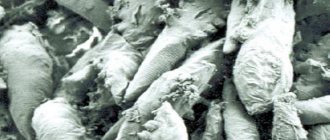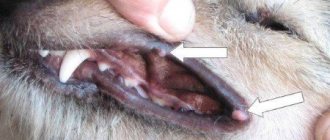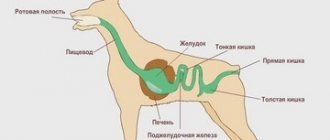Gastritis is an inflammation of the mucous membranes of the stomach. This pathology occurs quite often. Don’t worry too much; if you consult a specialist in a timely manner, the inflammation will go away very quickly.
If no measures are taken to improve the pet’s condition, the inflammation can spread further along the digestive tract. For example, gastroenteritis develops - inflammation of the mucous membranes of the stomach and intestines.
The causes of this disease are similar to those in humans, and among humans this disease occupies a leading place, so you have probably heard about it.
Causes of gastritis
In humans, the main cause of gastritis is the bacteria Helicobacter pylori, but in dogs there is no direct connection between the presence of these bacteria in the stomach and the development of inflammation.
The stomach of healthy animals is inhabited by Helicobacter - a wide range of acid-fast bacteria.
Inflammation of the stomach in dogs can develop for several reasons:
- Feeding disorders. This could be poor quality food, missing products, or simply “food from the table,” i.e. fried, smoked, fatty, etc.
- Food intolerance or allergy. Inflammation of the stomach is one of the consequences of these disorders in the body.
- Oral diseases/dental problems.
- Foreign bodies. This body could be a bone, or it could be something that is not even remotely edible. A foreign body can get stuck in the stomach itself and lower in the intestines. It (or they, if there are several of them) disrupts the patency of the digestive tract or can injure the gastric mucosa, which causes inflammation.
- Poisoning with toxic substances.
- Infestation by parasites. Some helminths live just on the gastric mucosa. They stick to it, release toxins and irritate the walls of the organ.
- Viral infection.
The above factors directly affect the development of inflammation in the stomach, but there are also secondary causes - diseases of a different nature (sometimes of completely different organs and systems), which one way or another can cause gastritis:
- Infectious diseases.
- Liver or kidney diseases.
- Stress.
- Injury.
- Hormonal disorders, such as hyperadrenocorticism or diabetes mellitus.
Chronic gastritis in dogs
Chronic gastritis is an inflammation of the gastric mucosa, characterized by sluggish pathological processes with periodic exacerbations. Clinically characterized by periodic vomiting, sometimes changeable appetite, and unpleasant odor from the animal’s mouth.
The disease can be complicated by erosions and ulcers, and then gastritis is called erosive or gastric ulcer. If previously old animals were susceptible to the disease, in recent years young dogs of many breeds, males (Lhasa Apso, miniature poodles, etc.) are increasingly affected.
Chronic irritation of the gastric mucosa leads to inflammation, which can spread to the submucosal layer. Long-term antigenic stimulation causes changes in immunity and allergization of the body and can be the cause of autoimmune chronic gastritis.
The development of chronic gastritis is predisposed by prolonged exposure to factors that cause acute gastritis. It can be provoked by intestinal helminths, medications (especially Rimadyl, which is often used unreasonably for a long time, glucocorticoids). A huge role in the occurrence of chronic gastritis is played by feeding animals with dry or wet commercial food, the artificial components of which have an irritating effect on the entire gastrointestinal tract and the gastric mucosa, in particular. Of great importance is the reduction in the resistance of the dog or cat’s body, as well as hereditary predisposition.
Diagnostics
Prolonged vomiting can lead to the development of gastroesophageal reflux, esophagitis and aspiration pneumonia due to irritation by the acidic contents of the esophageal mucosa. The diagnosis is made comprehensively based on history, clinical picture and laboratory data.
Chronic gastritis is characterized by vomiting of undigested food, often colored with bile with lumps of blood or with altered blood in the form of “coffee grounds,” especially with increased stomach acidity. Vomiting may occur daily or periodically, usually after eating or drinking. Its frequency increases as the disease progresses. Prolonged vomiting can lead to the development of gastroesophageal reflux, esophagitis and aspiration pneumonia due to irritation of the esophageal mucosa by the acidic contents. For gastritis with low stomach acidity, diarrhea is more typical, since the protein components of the diet are not fully digested. Other signs of the disease may be loss of appetite, melena, and diarrhea. With gastritis with high acidity, constipation may occur due to spasm of the pylorus.
In turn, several forms of chronic gastritis should be distinguished - superficial, chronic gastritis with lymphocytic, plasmacytic inflammatory infiltration, zozinophilic gastritis, granulomatous gastritis, atrophic gastritis. A biopsy can most accurately make a diagnosis and exclude other pathologies.
Laboratory data
General blood and urine tests are usually normal, except in cases of systemic disease. With hemorrhagic gastritis, anemia can be detected.
In severe dehydration, signs of hemoconcentration are observed. Eosinophilia is observed with a specific lesion, hypoproteinemia - with an advanced disease with severe protein loss. A fecal flotation test can detect intestinal parasites. Plain radiography of the abdominal organs can detect radiopaque foreign bodies, dilatation of the stomach and the presence of fluid in it due to pyloric stenosis. An X-ray contrast study will help clarify the cause of delayed gastric emptying (stenosis and other malformations).
During gastroscopy, along with macroscopic characteristics (atrophic gastritis, thinning of the mucous membrane, from under which the vessels of the submucosal layer protrude), a biopsy can be performed. A biopsy must be performed even if the mucous membrane appears normal. If after the studies the diagnosis remains unclear, diagnostic laparotomy is indicated, especially if signs of damage to the submucosal and other layers of the gastric wall are detected.
Symptoms
No matter what causes the inflammation of the gastric mucosa, if the process is acute, the symptoms are always similar.
The pain is usually not that severe. The first thing owners notice:
- Vomit. Usually it occurs suddenly, maybe with an admixture of bile or mucus, or even less often with an admixture of blood (due to bleeding in the stomach).
- Diarrhea. It may also be mixed with blood due to stomach bleeding.
- Conversely, there may be constipation. If the stool is dark, it means there is blood in it.
- General depression.
- Lack of appetite (not always, but may be the only sign!).
- When palpating the abdominal wall in the stomach area, the dog experiences pain. She herself will not tell you this, you can understand it by her behavior. She may start to growl or whine, depending on the animal's temperament. Even if your dog is silent like a guerrilla, pain can be recognized by the tension in the abdominal wall.
- Vomiting often occurs in the morning or immediately after eating, depending on whether the acidity in the stomach is high or low.
Treatment of gastritis in dogs
Only a doctor can prescribe treatment, since the form of the disease can be very different with high or low acidity.
In the acute form of gastritis, it is necessary to keep the animal on a starvation diet for at least a day. In the acute form of gastritis, it is necessary to keep the animal on a starvation diet for at least a day.- Gastric lavage is also prescribed, but giving emetics is not recommended. Two days after the diet, the animal is given mucous decoctions with the addition of raw chicken eggs. Later, vegetable or oatmeal soup, grated carrots, and minced lean meat are fed in small portions and often.
- When the body is dehydrated, saline is administered. intravenous solutions. Deep warm mucous enemas are performed.
- If gastritis is caused by exposure to an infection or pathogenic microflora, the veterinarian will prescribe antibiotic treatment. For constipation, the dog is given a laxative.
- In case of chronic gastritis, the animal is fed in small portions, but often. Al-Magel should be given before each feeding.
- If a decrease in stomach acidity or its complete absence is diagnosed, then replacement therapy is carried out. A mixture is prepared for the dog from two parts of diluted hydrochloric acid and the same amount of pepsin, as well as water. It is prescribed three times a day, up to two tablespoons before meals [31].
Gastroenteritis is one of the most common diseases of the digestive system in young animals, characterized by inflammation of the stomach and intestines, accompanied by indigestion, intoxication and dehydration.
Gastroenteritis is of primary and secondary origin; by the nature of inflammation - alterative (erosive-ulcerative, necrotic), exudative (serous, catarrhal, fibrinous, hemorrhagic and purulent) and less often productive; by localization - focal and diffuse; according to the course – acute and chronic. Exudative gastroenteritis is the most common.
Diagnostics
Gastritis is an easy disease to diagnose and treat. If you take the necessary measures in time.
The cause of the developed inflammation cannot always be determined, but this is not particularly important, except in cases of parasites or a foreign body.
Since the mild stage of gastritis is treated symptomatically, the primary diagnosis can be based on anamnesis (data about life, feeding, treatments and vaccinations, which the doctor learns from the owner) and on a physical examination.
Physical examination includes external examination of the animal, palpation and auscultation of the painful area.
If, based on the data obtained, the veterinarian does not see signs of systemic diseases and there is no severe abdominal (abdominal) pain, signs of obstruction or the presence of a foreign body, and he suspects gastritis, then symptomatic therapy and a special diet are prescribed. Often this is enough for the stomach to return to normal.
If after 2 days of such therapy the pet’s condition does not improve, it is necessary to conduct a full comprehensive examination in order to prescribe a full-fledged high-quality treatment!
For a high-quality diagnosis, the dog must endure a starvation diet. In situations where the dog has not eaten for more than two days, he is prescribed maintenance therapy in the form of nutritional drips.
If a foreign body or obstruction is suspected, they are sent for an X-ray with contrast (preliminary barium is removed).
Next, blood and urine are taken for laboratory tests.
If necessary, ultrasound diagnostics of the abdominal cavity is performed.
The most informative research method is gastroscopy. It is carried out using a special device - an endoscope. Unfortunately, it is not available in all veterinary clinics. If you don’t go into details, then with its help it is possible to directly see the changes occurring in the stomach and even remove some small tumors.
What and how to treat
If the diagnosis has been confirmed and the dog actually has gastritis, treatment always begins with a starvation diet and further correction of the diet (see below). If a helminthic infestation is suspected, unscheduled deworming in therapeutic doses is mandatory. Treatment of gastritis in dogs at home is allowed with the permission of a veterinarian and strictly according to his instructions. Independent attempts to eliminate the pathology can lead to its progression, up to gastric ulceration.
We recommend reading: Maine Coon cats: history and description of appearance, character and pet care
Treatment includes the following medications (all combinations, frequency of administration and course duration are determined only by a veterinarian!):
| Antiemetics, prokinetics |
|
| Secretion inhibitors |
|
| Enveloping drugs (dosages are selected individually, taking into account the dog’s weight and the course of the disease) |
|
| Antibiotic therapy in case of secondary bacterial infection (all drugs are taken for a minimum course of 14 days, maximum 21 days) |
|
| Anti-inflammatory drugs for allergic reactions | glucocorticosteroids (at the discretion of the attending physician): 0.5-1 mg/kg in terms of prednisolone 1-2 times a day in an individual course |
| Antispasmodics |
|
| Enzymatic preparations for impaired digestion of feed |
|
Types of gastritis
Inflammation in the stomach can be acute or chronic.
Acute gastritis is characterized by sudden severe vomiting and rapid development with increasing pain.
Chronic gastritis is a consequence of the acute stage. Usually in such cases, periodic vomiting continues for more than a week and then significant weight loss becomes noticeable.
According to the form they are distinguished:
- Erosive ulcerative gastritis. This form differs in that ulcers form on the gastric mucosa.
- Eosinophilic, lymphoplasmacytic and granulomatous gastritis - these forms are not clinically distinguished; they are differentiated only on the basis of histological (tissue) analysis. They are characterized by thickening of the stomach wall and increased levels of eosinophils. Usually caused by a parasitic infestation or an allergic reaction/food intolerance.
- Atrophic gastritis (it occurs chronically) is characterized by thinning of the walls of the stomach and atrophy of the gastric glands.
- Separately, it is worth highlighting chronic hypertrophic gastropathy . This form of pathology leads to disruption of gastric outflow and is characterized by severe vomiting immediately after eating for several days.
Treatment
- First of all, if the cause of inflammation is established, then it must be eliminated. For example, if gastritis is caused by any drug, then under the supervision of a veterinarian you need to stop it (and prescribe a harmless analogue). If the cause is helminthic infestation, then it is worth deworming.
- Next, the pet is prescribed a starvation diet for several hours so that the gastrointestinal tract “rests.”
- Resume feeding gradually. They give food often, but in small portions.
- It is very important to change feeding. We are not returning the previous diet. The veterinarian must prescribe a special diet.
- If necessary, infusion therapy is prescribed (droppers or subcutaneous administration of drugs). This is necessary if the animal is dehydrated.
- Next, at the doctor’s discretion, gastroprotectors are prescribed (most often sucralfate). They may also prescribe medications that stimulate peristalsis (stomach motility).
- In some cases, prednisolone is prescribed (here you need to be very careful with the dosage; you should not give it without the supervision of a veterinarian).
- The duration of treatment depends on the severity of the disease.
In any case, you need to understand that if a dog has once been diagnosed with gastritis, most likely the tendency to it will haunt the dog for the rest of its life. So be careful about feeding your pet.
All medications must be prescribed by a specialist; you should not resort to self-medication.
Diagnosis of gastritis in a dog
A history of periodic vomiting, diarrhea, and weight loss is often noted. A history of periodic vomiting, diarrhea, and weight loss is often noted.
Most cats with eosinophilic gastritis and/or gastroenteritis will have blood in the stool or as melena (black clotted blood). Physical examination reveals a decrease in body weight. In cases where the cause of the disease is hypereosinophilia syndrome, enlarged peripheral lymph nodes, mesenteric lymphadenopathy, hepato- and splenomegaly may be detected. In cats, palpation may reveal thickening and dilation of intestinal loops. Differential diagnosis is carried out with diseases that may cause the development of eosinophilic gastritis. In case of differential diagnosis, it is necessary to exclude idiopathic eosinophilic gastritis. It is also important to exclude damage by intestinal parasites, for which feces are examined. The search for a food component that could cause allergies is carried out using mono-diets (the gradual inclusion of new components in the diet). Using a biopsy, eosinophilic gastritis is differentiated from other inflammatory diseases of the gastrointestinal tract.
Diet for gastritis
It all depends on whether you feed your dog natural food or dry food. When choosing dry food, you should pay attention to the Gastro medicinal line. Royal Canin has such lines.
If your dog sits on a natural bed, it will be more difficult. Ideally, you need to contact a veterinary nutritionist so that he can create a balanced therapeutic diet specifically for your pet.
If this is not possible, then the main thing is to adhere to several rules:
- Eliminate all fatty meats. It is better to leave only rabbit or turkey meat.
- Cook porridge separately from meat.
- Do not give your dog meat broth - it is too fatty.
A good option would be boiled rice with low-fat cottage cheese. However, not every dog will agree to eat it.
Forecast
Prognosis for cats and dogs with lymphocytic-plasmacytic gastritis
often good if adequate therapy is given.
Some sources suggest that cats with lymphocytic gastritis develop lymphoma; however, it is possible that this is due to an initial misdiagnosis or that lymphoma develops independently of gastritis. The prognosis for eosinophilic gastritis in dogs is usually favorable. In cats, eosinophilic gastritis may present as part of a hypereosinophilic syndrome, which usually responds poorly to therapy. With hypereosinophilic syndrome, the prognosis is guarded. ^Top
Prevention
Even if your dog is not included in the breed risk group, it is still important to prevent the development of gastritis. For this:
- The dog's diet must be balanced and consist of approved foods.
- Do not feed your pet “from the table”. Even if he asks. Find recipes for healthy dog treats or buy ready-made ones at a pet store if you want to please your pet.
- Annual vaccinations and periodic treatments against worms are the basis for the prevention of many diseases.
- It is important to monitor not only the correctness of the diet, but also the size of portions.
- Regular oral hygiene. Here we are not even talking about the fact that dogs also need to brush their teeth (which, of course, is very important). It is necessary to at least regularly examine your pet’s mouth, and if you notice any changes, such as inflammation of the gums, tooth loss or tartar formation, then you need to take the dog to the veterinary clinic for oral sanitation.
Don't forget that the mouth is part of the digestive tract.
Briefly about the main thing
Gastritis is a common inflammatory disease of the stomach.
- There are many reasons for the development of inflammation, both directly leading to gastritis and through other diseases. The most common: improper feeding, poisoning with toxins or other drugs, eating plants, allergies or food intolerances, helminthic infestations, viral infections, foreign body in the stomach, trauma, stress, genetic predisposition, gastritis can be immune-mediated.
- Main symptoms: refusal to eat and sudden vomiting.
- Diagnosis must be carried out in a veterinary clinic. The diagnosis is made based on the data that the animal owner must provide (information about feeding, treatments, vaccinations and recent activity) and clinical research methods. Sometimes additional diagnostics are performed (fluoroscopy, ultrasound diagnostics, gastroscopy).
- Treatment depends on the stage of inflammation and the general well-being of the dog. All medications must be prescribed by a veterinarian; you should not self-medicate.
- Some dogs have a genetic predisposition to certain forms of gastritis.
How to treat acute gastritis in a dog
Acute gastritis is treated primarily with symptomatic drug and dietary therapy. If the specialist does not find parasites or microbes in the animal’s tests against which drug treatment should be started, the dog is prescribed a special diet.
The first day the animal is kept on a starvation diet. After a day of hunger strike, the dog is given a specialized diet in small portions. Sometimes, if an animal becomes dehydrated due to profuse and frequent vomiting, the lack of water is replenished with intravenous injections, since the usual method of drinking fluid can cause repeated vomiting.
As a rule, after 2-3 days acute gastritis passes, and the animal can be transferred to a normal diet. However, experts recommend reconsidering the animal’s diet, especially if the cause of gastritis is precisely poor nutrition: change the food, see if the animal eats something besides its diet.
If gastritis is chronic, then the approach to treatment changes. The animal is prescribed anti-inflammatory drugs and a special diet. Instead of fasting, the dog is fed frequently and in small portions. With chronic gastritis, it is important to regularly show your dog to a veterinarian and get tested.
Since the etiology of chronic gastritis is difficult to establish, the dog is prescribed a number of general medications: for example, gels that protect the stomach walls from repeated inflammation, antihistamines that exclude allergies, and antibiotics. It is important not to self-medicate. Experts note that many forms of gastritis occur secretly and go away on their own within 2-3 days. But if you notice that something is wrong with your dog, take it to a specialist.
Acute gastritis can easily become chronic, and chronic gastritis most often turns into an ulcer if not treated correctly. In addition, there is a correlation between gastritis, ulcers and gastrointestinal cancer.










